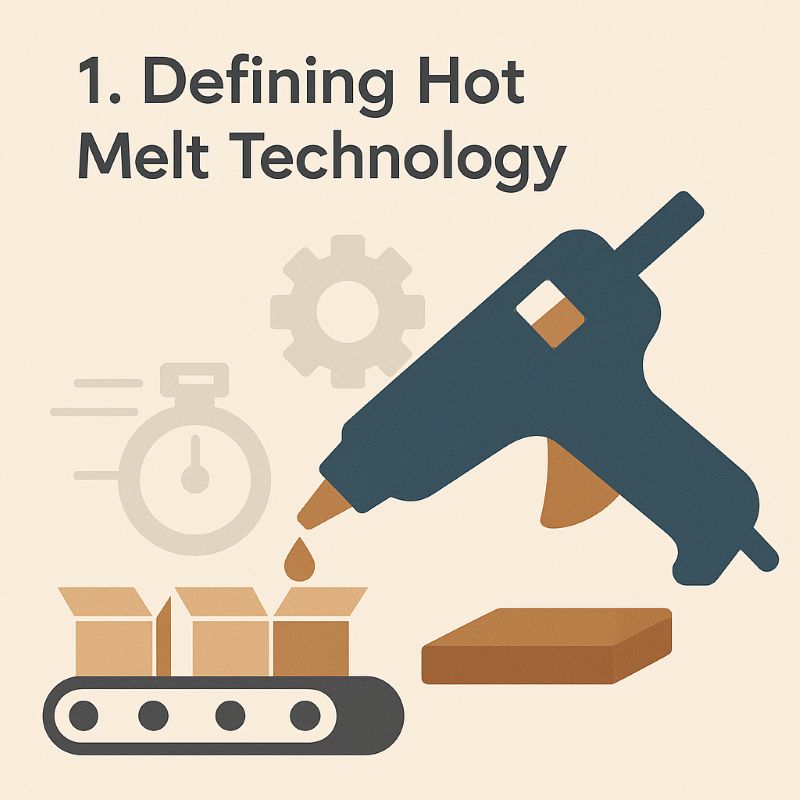
Defining Hot Melt Technology
Types of Hot Melt Adhesives
Importance in Manufacturing
Methods of Application
Latest Trends in Hot Melt
Strategies for Innovation
Challenges and Solutions
Frequently Asked Questions (FAQ)
Hot melt technology refers to the use of thermoplastic adhesives that are applied in a molten state and solidify upon cooling. This process allows for rapid bonding, making it highly effective for modern manufacturing operations. The technology enhances production speed, minimizes downtime, and ensures consistent bonding performance across various applications. Its versatility and efficiency have made it a key enabler in high-speed manufacturing environments.
Hot melt adhesives are categorized into several types based on their chemical composition and performance characteristics. Common types include:
EVA (Ethylene-Vinyl Acetate): Offers a balance of flexibility and strength.
Polyolefin: Known for excellent adhesion to non-porous surfaces and low-temperature flexibility.
Polyamide: Offers high heat resistance and chemical stability.
Pressure-Sensitive Adhesives (PSA): Remain tacky at room temperature for repositionable bonding.
Each type serves specific industrial needs, from packaging and automotive to electronics and filtration.
Hot melt technology plays a pivotal role in manufacturing by streamlining bonding processes, reducing drying or curing time, and allowing continuous operation on automated lines. Its quick set time and strong bonding capability make it suitable for high-throughput production. Additionally, hot melt systems typically result in less waste and lower energy consumption compared to solvent-based adhesives, aligning with sustainability goals and operational efficiency.
Various application methods enable the precise delivery of hot melt adhesives:
Bead Application: For linear or spot bonding.
Spray Application: For wide-area or irregular surface coverage.
Slot Die Coating: For uniform adhesive layering on continuous substrates.
These methods are implemented through specialized hot melt dispensing systems, each selected based on the material, geometry, and bonding requirements of the product.
Recent trends in hot melt technology reflect growing demand for sustainability and smart manufacturing:
Eco-Friendly Formulations: Newer adhesives are designed to reduce environmental impact while maintaining performance.
Smart Adhesives: Incorporate sensors or responsive materials for dynamic performance control.
Industry 4.0 Integration: Advanced systems now offer real-time monitoring, data analytics, and automated adjustment of application parameters.
These innovations contribute to higher efficiency, reduced waste, and improved quality control.
To stay competitive, manufacturers are:
Investing in R&D: Developing formulations that meet both performance and regulatory demands.
Integrating Digital Technology: Enabling process optimization through real-time control and diagnostics.
Collaborating Across Supply Chains: Sharing knowledge and aligning specifications to accelerate innovation.
These strategies enhance flexibility, sustainability, and productivity in adhesive-related processes.
Manufacturers face several challenges in hot melt operations:
Equipment Upgrades: Keeping pace with evolving technology can require capital investment.
Environmental Regulations: There’s increasing demand for low-emission, recyclable adhesive solutions.
Process Complexity: High-precision application systems demand skilled operation and maintenance.
Solutions include adopting modular, user-friendly hot melt systems, transitioning to green-certified adhesives, and implementing operator training programs to ensure optimal use of new technology.
Q1. What is hot melt technology?
It involves applying thermoplastic adhesives in a molten state that solidify upon cooling to form strong bonds efficiently.
Q2. What are the types of hot melt adhesives?
Common types include EVA, polyolefin, polyamide, and pressure-sensitive adhesives, each offering specific advantages for industrial applications.
Q3. Why is hot melt technology important in manufacturing?
It increases production speed, reduces processing time, and improves bond quality, supporting high-volume, automated manufacturing.
Q4. What methods are used for applying hot melt adhesives?
Bead, spray, and slot die coating methods are used to match application needs ranging from pinpoint bonding to full-surface coating.
Q5. What are the latest trends in hot melt technology?
Trends include eco-friendly adhesive development, smart systems for real-time control, and full integration into Industry 4.0 ecosystems.
Q6. How can manufacturers foster innovation in hot melt technology?
By investing in R&D, embracing digital transformation, and fostering supplier partnerships to stay ahead of performance and regulatory shifts.
Q7. What challenges do manufacturers face with hot melt technology?
These include keeping up with equipment advances, meeting environmental standards, and managing precision in adhesive application.
Q8. What are the solutions to these challenges?
Solutions include adopting adaptable, efficient equipment, choosing sustainable adhesive options, and improving operator skill sets through training.